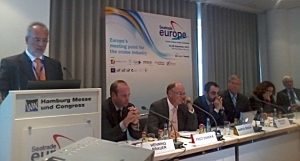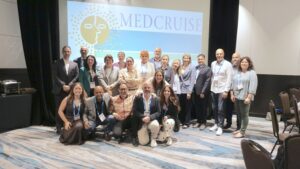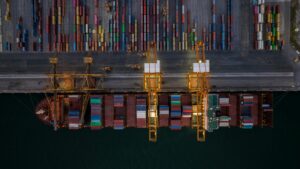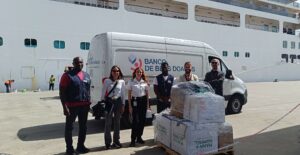MedCruise President Stavros Hatzakos joined environmental experts on a Seatrade Europe panel that agreed about the general advantages of LNG as an alternative fuel but said considerable doubts remain about supply logistics the timeline for applicability to cruising and the environmental value of interim ‘bridge technologies.’ MedCruise president Stavros Hatzakos focused on the fact that supplying LNG causes problems for smaller ports as resources and space to accommodate the logistical infrastructure may be lacking.
Wärtsilä’s Fred Danska director-cruise business detailed various alternative fuels and clearly advocated the use of LNG as the best approach for cruising into a greener future. He referred to the ferry sector where Viking Line’s LNG-powered Viking Grace operates between Sweden and Finland.
‘She is a good reference’ Danska stressed adding that LNG is actually a safer fuel option than heavy fuel oil given its relatively high flash point.
Looking at the economic side Danska said LNG is highly attractive if lifecycle costs extending over a period of 20 years are considered. With these advantages he sees LNG as a global solution for the maritime industry and cruise shipping in particular while bio fuel may be a local solution rather than an approach for globally deployed vessels.
With regard to the intensely debated availability of LNG Danska said safety technology and even costs are not real issues as ‘there will always be someone to supply it if clients want it.’ The biggest problem about the availability of LNG in ports is “bureaucracy” not safety or anything else’ Danska concluded. Yet he voiced optimism that this too will get resolved.
Other panelists though were less euphoric about LNG.
Royal Caribbean Cruises Ltd.’s Rich Pruitt avp safety & environmental stewardship who moderated the ‘Environmental Advances in Cruise Ship Technology’ session said consumers are not demanding LNG but are open to other solutions.
In contrast some cruisers are sceptical of LNG. AIDA Cruises’ chief sustainability officer Monika Griefahn referred to the LNG Barge which AIDA will use to supply power to berthed ships in Hamburg starting next year and said it was ‘extremely difficult to get the bureaucracy settled for that project.’
Outlining the time needed to implement the LNG solution Griefahn said there are other approaches such as filters which can be realised more quickly. ‘Let’s see which option is the quickest and most effective one to reduce emissions’ she suggested.
Another problem panelists discussed was the difficulty of converting existing ships for LNG use. According to Danska LNG requires about 3.5 times the tank volume needed for conventional fuel. This means passenger and crew decks have to be cut into to make room for new storage facilities.
Given these constraints Danska proposed the use of scrubbers as an intermediate solution suitable for existing ships. He said a mix of existing ships equipped with scrubbers burning heavy fuel oil others burning MGO and new ships applying LNG may be the answer for the industry and also help to keep fuel costs at bay.
Henning Brauer head of project management at Hapag-Lloyd Cruises detailed Europa 2 which entered service in the spring. It was fitted with a highly innovative water treatment plant and is the first cruise ship equipped with an SCR-catalytic converter which reduces nitrogen oxide emissions by almost 95%.
Brauer said experiences with this new technology have been favourable. It has been in operation for about 150 days and Hapag-Lloyd is ‘very happy with it.’ He added: ‘We can absolutely recommend the SCR-catalytic converter for newbuildings although retrofits may be difficult due to space constraints.’
Some controversy emerged about shore power which a few panelists dismissed as just ‘greenwash’ and a short-term solution unless -for example in Alaska- the energy is generated from renewable resources such as hydropower.
Griefahn called cold ironing a ‘bridge technology’ explaining AIDA had chosen the innovative LNG Barge approach for Hamburg to avoid using shore power generated by coal plants. The company’s next-generation newbuild under construction in Japan and expected to set new environmental standards will have dual-fuel engines access for shore power and be able to connect to the LNG barge.
In general terms Griefahn outlined the need for clear and reliable legislation and suggested a ‘hierarchy of solutions’ be defined by the industry in order to replace shortsighted solutions with a long-term structured approach.
Summarising the panel’s opinion LNG will certainly stand at the top of that hierarchy but a considerable way to be covered by “bridge technologies” remains until the destination is reached.
Article: Report based on www.seatrade-insider.com





